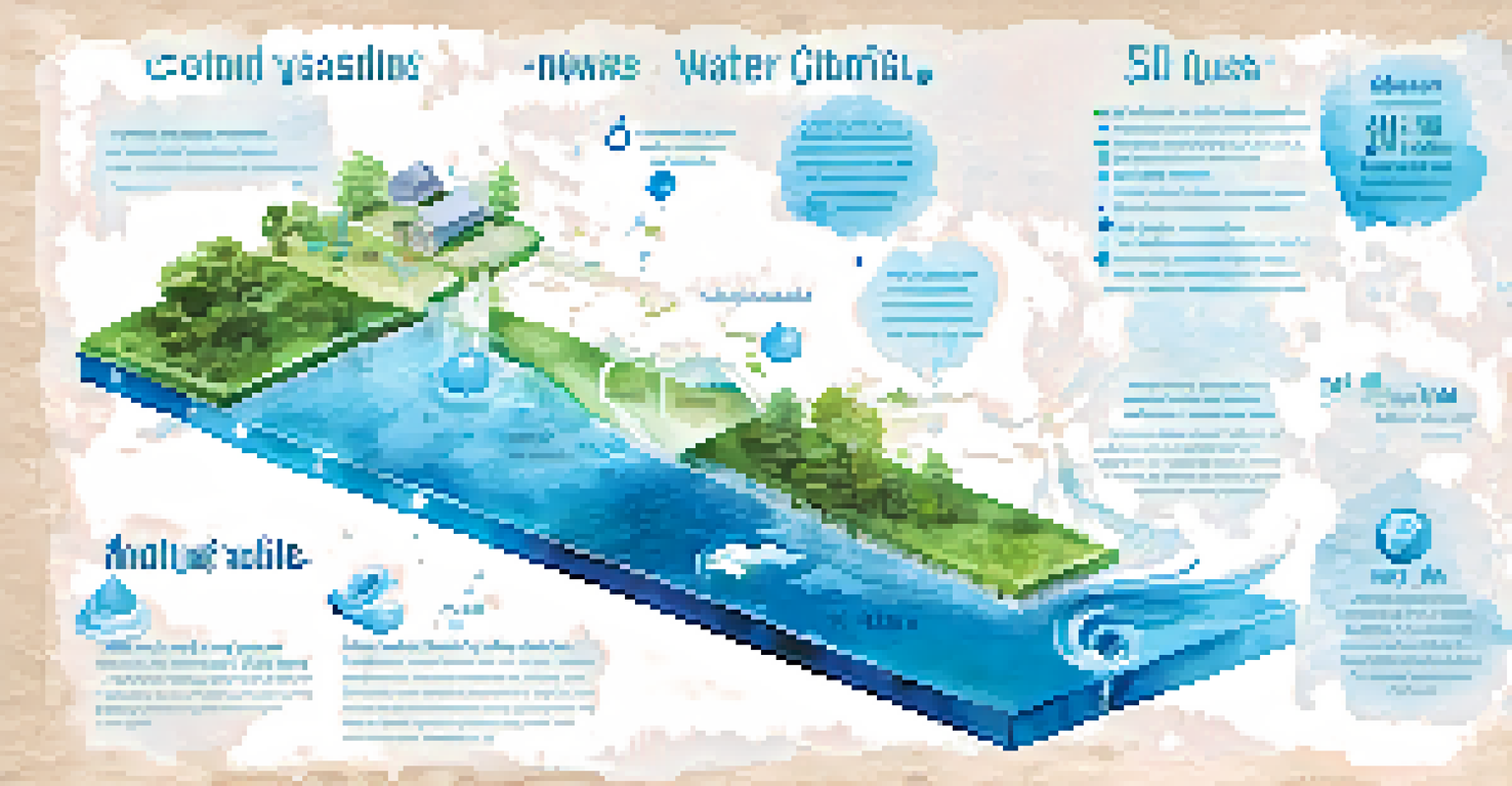Water Usage in Fashion: An Overlooked Climate Factor

Understanding Water Footprint in Fashion
The term 'water footprint' refers to the total volume of freshwater used to produce goods, including fashion items. This concept is crucial because, while we often hear about carbon footprints, water usage tends to fly under the radar. From cotton cultivation to dyeing processes, the fashion industry consumes an astounding amount of water—much more than most people realize.
Water is the most precious resource for life, and it is vital to our future. We must learn to use it wisely.
For instance, it takes approximately 2,700 liters of water to produce just one cotton t-shirt. That’s enough water for one person to drink for two and a half years! By highlighting these figures, we can begin to understand the significance of water consumption in the fashion sector.
As consumers, we often associate sustainability with materials and manufacturing practices, but the hidden water costs are just as critical. Recognizing the water footprint encourages more mindful consumption and supports brands that prioritize sustainable practices.
The Role of Cotton: A Thirsty Crop
Cotton is one of the most commonly used materials in fashion, but its cultivation is incredibly water-intensive. In fact, cotton farming accounts for a significant portion of the world's agricultural water usage. This raises questions about the sustainability of using cotton, especially in regions where water scarcity is already a pressing issue.

Consider the fact that the majority of cotton is grown in countries like India and the United States, where water resources can be strained. The impact of cotton farming goes beyond just water; it also affects local ecosystems and communities reliant on these water sources for their livelihoods.
Fashion's Hidden Water Footprint
The fashion industry consumes vast amounts of water throughout production, from cotton farming to dyeing processes.
This is a wake-up call for both consumers and manufacturers. By seeking alternative materials or supporting organic cotton, we can help reduce the water burden associated with traditional cotton farming.
Water in Dyeing: The Hidden Costs
Once fabrics are produced, they often undergo dyeing processes that require copious amounts of water. Traditional dyeing methods can waste more than 200 liters of water for just one kilogram of fabric. This not only strains local water supplies but can also lead to pollution when untreated wastewater is released into rivers and streams.
The greatest danger in times of turbulence is not the turbulence; it is to act with yesterday's logic.
Moreover, the chemicals used in dyeing can be harmful to both the environment and human health. From toxic runoff to contaminated water sources, the dyeing process is a critical area of concern in the fashion industry. The pollution generated can devastate local ecosystems, affecting both wildlife and communities.
As a solution, many brands are now exploring waterless dyeing technologies and more sustainable practices. By demanding cleaner and more efficient dyeing methods, consumers can drive the industry toward a more responsible future.
Fast Fashion's Water Impact
Fast fashion is notorious for its rapid production cycles and low prices, but this comes at a significant environmental cost. The quick turnaround of trends leads to increased water usage, with many garments being produced without considering their long-term impact on water resources. This model not only encourages overconsumption but also exacerbates water scarcity issues.
For example, a single fast-fashion collection can consume thousands of liters of water, contributing to a cycle of waste and depletion. As consumers purchase more and more, the industry responds with even faster production times, leading to an endless loop of water wastage.
Fast Fashion Exacerbates Scarcity
The rapid production cycles of fast fashion lead to increased water usage and contribute to global water scarcity.
By choosing to buy less and invest in quality, sustainable pieces, consumers can play a crucial role in mitigating the water crisis tied to fast fashion. Supporting brands that prioritize sustainability over speed can help shift the entire industry toward a more responsible model.
The Global Water Crisis: A Fashion Perspective
The global water crisis is a pressing issue that affects millions of people worldwide. While we often think of water scarcity in relation to drinking water, industrial sectors like fashion play a significant role in exacerbating the problem. As freshwater sources dwindle, the fashion industry must confront its responsibility in contributing to this crisis.
Many regions affected by water scarcity are also the same areas where cotton is grown and garments are produced. This creates a dire situation where local populations struggle for water while the fashion industry continues to consume it at alarming rates. Understanding this connection is vital to fostering change.
By raising awareness of the water crisis within the context of fashion, we can encourage a more holistic approach to sustainability. Consumers and brands alike need to recognize the urgency of this issue and work collaboratively toward solutions that benefit both people and the planet.
Innovations in Sustainable Fashion
Amidst the challenges posed by water usage in fashion, innovative solutions are emerging to promote sustainability. Brands are increasingly adopting practices that minimize water consumption, such as using recycled water in production processes or implementing water-efficient technologies. These innovations not only help reduce the industry's overall water footprint but also set a precedent for responsible practices.
For instance, some companies are utilizing sustainable materials like Tencel, which requires less water to produce than cotton. Other brands are experimenting with digital printing techniques that consume significantly less water compared to traditional dyeing methods. These advancements demonstrate that change is possible and can be done without sacrificing style.
Innovations for Sustainable Fashion
Emerging sustainable practices and technologies are helping brands reduce their water consumption and environmental impact.
As consumers, it’s essential to support and advocate for these forward-thinking brands. By choosing to invest in companies that prioritize innovation and sustainability, we can help pave the way for a more responsible fashion industry.
Empowering Consumers to Make a Difference
Consumers hold significant power in the fashion industry, and understanding water usage is a crucial step toward making informed choices. By educating ourselves about the environmental impacts of the clothes we buy, we can drive demand for change. This means looking beyond the price tag and considering a brand’s commitment to sustainability.
Simple actions, like researching brands before making purchases or opting for second-hand clothing, can collectively create a substantial impact. Every time we choose to support a sustainable option, we send a message to the industry that water conservation matters.

Ultimately, empowering consumers to become advocates for sustainable fashion can lead to a more conscientious market. Together, we can foster a culture of accountability and responsibility, ensuring that future generations inherit a healthier planet.